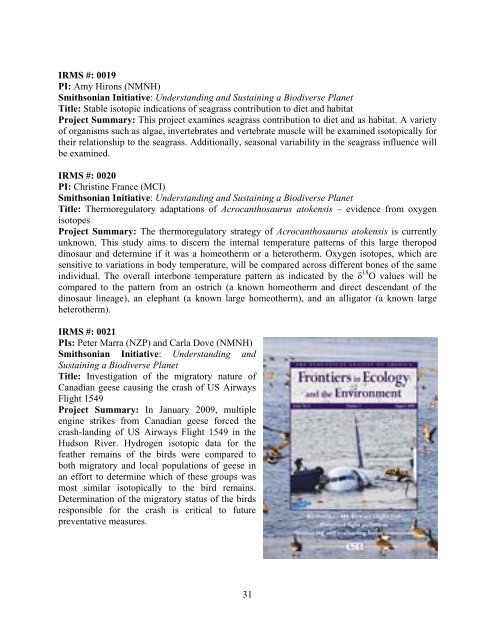MCI Project Summaries 2008 - Smithsonian Institution
MCI Project Summaries 2008 - Smithsonian Institution
MCI Project Summaries 2008 - Smithsonian Institution
Create successful ePaper yourself
Turn your PDF publications into a flip-book with our unique Google optimized e-Paper software.
IRMS #: 0019<br />
PI: Amy Hirons (NMNH)<br />
<strong>Smithsonian</strong> Initiative: Understanding and Sustaining a Biodiverse Planet<br />
Title: Stable isotopic indications of seagrass contribution to diet and habitat<br />
<strong>Project</strong> Summary: This project examines seagrass contribution to diet and as habitat. A variety<br />
of organisms such as algae, invertebrates and vertebrate muscle will be examined isotopically for<br />
their relationship to the seagrass. Additionally, seasonal variability in the seagrass influence will<br />
be examined.<br />
IRMS #: 0020<br />
PI: Christine France (<strong>MCI</strong>)<br />
<strong>Smithsonian</strong> Initiative: Understanding and Sustaining a Biodiverse Planet<br />
Title: Thermoregulatory adaptations of Acrocanthosaurus atokensis – evidence from oxygen<br />
isotopes<br />
<strong>Project</strong> Summary: The thermoregulatory strategy of Acrocanthosaurus atokensis is currently<br />
unknown. This study aims to discern the internal temperature patterns of this large theropod<br />
dinosaur and determine if it was a homeotherm or a heterotherm. Oxygen isotopes, which are<br />
sensitive to variations in body temperature, will be compared across different bones of the same<br />
individual. The overall interbone temperature pattern as indicated by the δ 18 O values will be<br />
compared to the pattern from an ostrich (a known homeotherm and direct descendant of the<br />
dinosaur lineage), an elephant (a known large homeotherm), and an alligator (a known large<br />
heterotherm).<br />
IRMS #: 0021<br />
PIs: Peter Marra (NZP) and Carla Dove (NMNH)<br />
<strong>Smithsonian</strong> Initiative: Understanding and<br />
Sustaining a Biodiverse Planet<br />
Title: Investigation of the migratory nature of<br />
Canadian geese causing the crash of US Airways<br />
Flight 1549<br />
<strong>Project</strong> Summary: In January 2009, multiple<br />
engine strikes from Canadian geese forced the<br />
crash-landing of US Airways Flight 1549 in the<br />
Hudson River. Hydrogen isotopic data for the<br />
feather remains of the birds were compared to<br />
both migratory and local populations of geese in<br />
an effort to determine which of these groups was<br />
most similar isotopically to the bird remains.<br />
Determination of the migratory status of the birds<br />
responsible for the crash is critical to future<br />
preventative measures.<br />
31

















